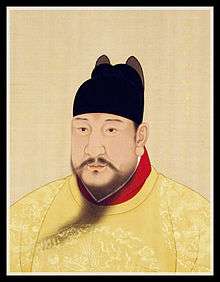House of Zhu
| Zhu | |
|---|---|
| Country | Ming China |
| Ethnicity | Han Chinese |
| Founded | 1368 |
| Founder | Hongwu Emperor |
| Current head | No |
| Final ruler | 1644: Chongzhen Emperor, Southern Ming: Yongli Emperor |
| Titles |
|
| Religion |
Confucianism Taoism Buddhism Chinese Folk Religion Catholicism |
| Estate(s) | Forbidden City, Beijing |
| Deposition |
|
House of Zhu, also known as House of Chu (Chinese: 朱; pinyin: Zhū; Wade–Giles: Chu), was the imperial family of the Ming dynasty of China. Zhu was the family name of the emperors of the Ming dynasty. The House of Zhu ruled China from 1368 until the fall of the Ming dynasty in 1644, followed by the rule as the Southern Ming dynasty until 1662, and the last Ming princes, the Prince of Ningjing Zhu Shugui and Prince Zhu Honghuan (朱弘桓) held out until the annexation of the Kingdom of Tungning in 1683.
Family history
Founder
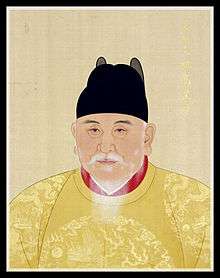
The founder of the Ming dynasty was the Hongwu Emperor (21 October 1328 – 24 June 1398), who is also known variably by his personal name "Zhu Yuanzhang" and his temple name "Taizu of Ming" (literally "Great Ancestor of Ming"). He was the first emperor of the Ming dynasty. His regnal name, Hongwu, means "vastly martial".
In the middle of the 14th century, with famine, plagues and peasant revolts sweeping across China, Zhu Yuanzhang became a leader of an army that conquered China, ending the government of the Mongol-led Yuan dynasty, and forcing the Mongols to retreat to present-day Mongolia. With his seizure of the Yuan capital Khanbaliq (present-day Beijing), he claimed the Mandate of Heaven and established the Ming dynasty in 1368. The Ming's mission was to drive away the Mongols and restore Han Chinese rule in China.
Under the Hongwu Emperor's rule, the Mongol bureaucrats who dominated the government in the Yuan dynasty were replaced by Han Chinese officials. The Hongwu Emperor revamped the traditional Confucian examination system. Mongol-related things, including garments and names, were discontinued from use and boycotted. There were also attacks on palaces and administrative buildings previously used by the Mongol rulers.[1]
Rise of the Ming dynasty
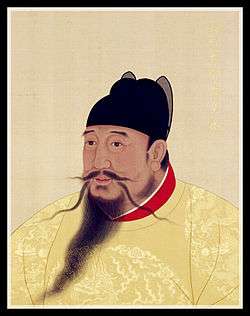
The Hongwu Emperor's grandson, Zhu Yunwen, assumed the throne as the Jianwen Emperor (r. 1398–1402) after the Hongwu Emperor's death in 1398. In a prelude to a three-year-long civil war beginning in 1399,[2] the Jianwen Emperor became engaged in a political showdown with his uncle Zhu Di, the Prince of Yan. The Jianwen Emperor was aware of the ambitions of his prince uncles, establishing measures to limit their authority. The militant Zhu Di, given charge over the area encompassing Beijing to watch the Mongols on the frontier, was the most feared of these princes. After the Jianwen Emperor arrested many of Zhu Di's associates, Zhu Di plotted a rebellion. Under the guise of rescuing the young Jianwen Emperor from corrupt officials, Zhu Di personally led forces in the revolt; the imperial palace in Nanjing was burned to the ground. The Jianwen Emperor, his wife, mother, and courtiers were supposedly killed. Having overthrown his nephew, Zhu Di seized the throne and became known as the Yongle Emperor (r. 1402–1424); his reign is universally viewed by scholars as a "second founding" of the Ming dynasty since he reversed many of his father's policies.[3]
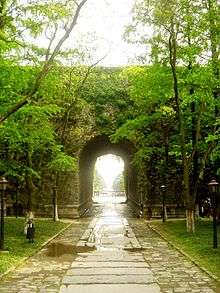
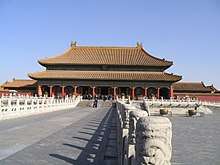
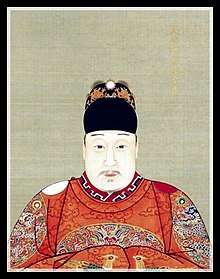
After his coronation, the Yongle Emperor decided to move China's capital from Nanjing (lit. "Southern Capital") to Beijing (lit. "Northern Capital"). According to a popular legend, the capital was moved when the emperor's advisers brought the emperor to the hills surrounding Nanjing and pointed out the emperor's palace showing the vulnerability of the palace to artillery attack.
The Yongle Emperor also ordered to build a massive network of structures in Beijing in which government offices, officials, and the imperial family itself resided. After a painfully long construction time, the Forbidden City was finally completed and became the political capital of China for the next 500 years.
皇孫府[4] The Ming dynasty modified and made changes from the Tang dynasty system for regulating the Imperial family.[5][6]
The early Ming Emperors from Hongwu to Zhengde continued Yuan practices such as hereditary military institutions, demanding Korean concubines and eunuchs, having Muslim eunuchs, wearing Mongol style clothing and Mongol hats, engaging in archery and horseback riding, patronizing Tibetan Buddhism, with the early Ming Emperors seeking to project themselves as "universal rulers" to various peoples such as Central Asian Muslims, Tibetans, and Mongols, modeled after the Mongol Khagan, however, this history of Ming universalism has been obscured and denied by historians who covered it up and presented the Ming as xenophobes seeking to expunge Mongol influence and presenting while they presented the Qing and Yuan as "universal" rulers in contrast to the Ming.[7][8][9][10] The Zhengde Emperor even learned to speak Mongolian and Tibetan.[11] The martial themed Ming dynasty Grand Review was copied by the Qing, as noted in rebuke to those who sought to present it as a Qing feature from the "New Qing History" school, in a review of David M. Robinson's Martial Spectacles of the Ming Court.[12]
Hongu had a "mirror" 宗藩昭鑒錄 宗藩昭鉴录 宗藩昭鑑錄 written for Ming Princes to educate them and stop misbehavior after having to discilpine his nephew Zhu Wenzheng's son, grandnephew Zhu Shouqian.[13][14]
Military power was delegated to princes.[13] Korean and Mongol women were among the concubines of Zhu Yuanzhang who bore his 26 sons. The sons of the founder were given their own fiefs.[15]
Land was granted to the Princes as their fiefs during the Ming.[16] The Ming dynasty granted fiefs to its Princes.[17] In the 17th century were more than 80,000 members of the Ming Imperial Zhu family.[18] The Ming drew on the example of the Song dynasty Imperial family.[19][20][21]
The Prince Liaojian was Zhu Quan.[22] Zhu Yuelian was the Prince of Shu.[23]
One of the Princes was noted for delinquent behavior. Zhu Shuang 朱樉 (Prince Min of Qin 秦愍王) while he was high on drugs, had some Tibetan boys castrated and Tibetan women seized after a war against minority Tibetan peoples and as a result was reprimanded after he died from overdose.[24][25][26][27][28][29][30][31][32][33] 征西番,將番人七八歲幼女擄到一百五十名,又將七歲,八歲,九歲,十歲男童,閹割百五十五名,未及二十日,令人馱背赴府,致命去處所傷未好,即便挪動,因傷致死著大
The Prince of Ning rebellion was led by Prince Zhu Chenhao. An accomplished military commander and archer was demoted to commoner status on a wrongful charge of treason was the Prince of Lu's grandson in 1514.[34]
At the Guozijian, law, math, calligraphy, equestrianism, and archery were emphasized by the Ming Hongwu Emperor in addition to Confucian classics and also required in the Imperial Examinations .[35]
Archery and equestrianism were frequent pastimes by Zhengde.[36] He practiced archery and horseriding with eunuchs.[37] Tibetan Buddhist monks, Muslim women and musicians were obtained and provided to Zhengde by his guard Ch'ien Ning, who acquainted him with the ambidextrous archer and military officer Chiang Pin.[38] An accomplished military commander and archer was demoted to commoner status on a wrongful charge of treason was the Prince of Lu's grandson in 1514.[34]
He was disinterested in military matters but had prowess in archery (Hongxi Emperor).[39]
Archery competitions, equestrianism and calligraphy were some of the pastimes of Wanli Emperor.[40]
The Imperial Princes who were enfeoffed were kept under heavy control by the Ming government.[41]
Decline
The financial drain of the Imjin War in Korea against the Japanese was one of the many problems—fiscal or other—facing Ming China during the reign of the Wanli Emperor (r. 1572–1620). In the beginning of his reign, the Wanli Emperor surrounded himself with able advisors and made a conscientious effort to handle state affairs. His Grand Secretary Zhang Juzheng (in office from 1572 to 1582) built up an effective network of alliances with senior officials. However, there was no one after Zhang Juzheng who was as excellent as him in maintaining the stability of these official alliances;[42] these officials soon banded together in opposing political factions. Over time, the Wanli Emperor grew tired and frustrated about court affairs and frequent political quarreling amongst his ministers, and chose to stay behind the walls of the Forbidden City and out of his officials' sight.[43]
Officials aggravated the Wanli Emperor about which of his sons should succeed to the throne; he grew equally disgusted with senior advisors constantly bickering about how to manage the state.[43] There were rising factions at court and across the intellectual sphere of China stemming from the philosophical debate for or against the teaching of Wang Yangming (1472–1529), the latter of whom rejected some of the orthodox views of Neo-Confucianism.[44][45] Annoyed by all of this, the Wanli Emperor began neglecting his duties, remaining absent from court audiences to discuss politics, lost interest in studying the Confucian Classics, refused to read petitions and other state papers, and stopped filling the recurrent vacancies of vital upper level administrative posts.[43][46] Scholar-officials lost prominence in administration as eunuchs became intermediaries between the aloof emperor and his officials; any senior official who wanted to discuss state matters had to persuade powerful eunuchs with a bribe simply to have his demands or message relayed to the emperor.[43]
Fall of the Ming dynasty
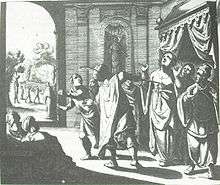
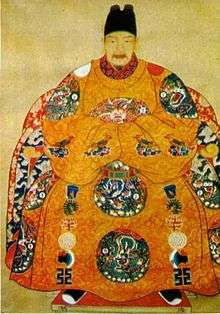
In the early 1630s, a Minister named Li Zicheng (1606–45) mutinied with his fellow soldiers in western Shaanxi.[47] Li's rebel forces retaliated the government by killing the officials, and led a rebellion based in Rongyang, central Henan province by 1635.[48] By the 1640s, an ex-soldier and rival to Li—Zhang Xianzhong (1606–47)—had created a firm rebel base in Chengdu, Sichuan, while Li's center of power was in Hubei with extended influence over Shaanxi and Henan.[48]
Meanwhile, after years of providing tremendous support to the Korean royal family during the Imjin War against Japanese warlord Hideyoshi, the Ming military and finance, which had not gotten fully recovered, were forced to go into the new battles. Exhausted, Unpaid and unfed, the Ming army was struggling hard between the Manchu raiders from the north and huge peasant revolts in the provinces. Eventually, the Ming army fell apart, and was defeated by Li Zicheng—who called himself the King of Shun—and took the capital without much of a fight.[49] On 26 May 1644, Beijing fell to Li Zicheng's rebel forces; during the turmoil, rather than facing capture and probable execution at the hands of the rebels, the Chongzhen Emperor arranged a feast and gathered all members of the imperial household aside from his sons. Using his sword, he killed all of them there. All people died except his second daughter, Princess Changping, whose attempt to resist the sword blow resulted in her left arm being severed by her father. The Chongzhen Emperor then went to Jingshan Hill, and hanged himself with the hair covering his face on a tree in the imperial garden outside the Forbidden City.[49]
After the Ming dynasty
Since the fall of the Ming Empire, the Manchu-led Qing dynasty started persecuting the Zhu clan, hence a number of members of the Zhu family have changed their surnames to Zhou (周),[50] Wang (王),[51] Gao (高),[52] Guang (廣),[53] Dong (東),[54] Zhang (張), Zhuang (莊),[55][56] and Yan (嚴).[55] Some of them changed their family names back to Zhu after the collapse of the Qing dynasty.
Several Ming princes accompanied Koxinga to Taiwan in 1661-1662, including the Prince of Ningjing Zhu Shugui[57] and Prince Zhu Honghuan (朱弘桓), son of Zhu Yihai, where they lived in the Kingdom of Tungning. Koxinga's grandson Zheng Keshuang surrendered to the Qing dynasty in 1683 and was rewarded by the Kangxi Emperor with the title "Duke of Haicheng" (海澄公) and he and his soldiers were inducted into the Eight Banners.[58][59][60] The Qing sent the 17 Ming princes still living on Taiwan back to mainland China where they spent the rest of their lives in exile since their lives were spared from execution.[61]
In 1725, the Yongzheng Emperor bestowed the hereditary title of marquis on a descendant of the Ming imperial family, Zhu Zhiliang, who received a salary from the Qing government and whose duty was to perform rituals at the Ming tombs, and was also inducted the Chinese Plain White Banner in the Eight Banners. Later, the Qianlong Emperor bestowed the title Marquis of Extended Grace posthumously on Zhu Zhuliang in 1750, and the title passed on through twelve generations of Ming descendants until the end of the Qing dynasty.
In 1912, after the overthrow of the Qing dynasty in the Xinhai Revolution, some advocated that a Han be installed as Emperor, either the descendant of Confucius, who was the Duke Yansheng,[62][63][64][65][66] or the Ming dynasty Imperial family descendant, the Marquis of Extended Grace.[67][68]
Notable members
Ming dynasty (1368–1644 C.E.)
- Hongwu Emperor, key leader of the rebel movement which ousted the Mongol-led Yuan dynasty; founder of the Ming dynasty
- Jianwen Emperor, grandson of the Hongwu Emperor; second emperor of the Ming dynasty reigned from 1399 to 1402; overthrown by his uncle, the Yongle Emperor
- Yongle Emperor, fourth son of the Hongwu Emperor and third emperor of the Ming dynasty; reigned from 1403 to 1424; he was responsible for expanding China's influence throughout Asia, East Africa and perhaps beyond through his fleet of treasure ships led by the admiral eunuch Zheng He; he founded the Forbidden City and the Ming Dynasty Tombs
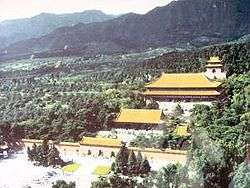
- Hongxi Emperor, eldest son of the Yongle Emperor and fourth emperor of the Ming dynasty; he reigned for one year, 1425
- Xuande Emperor, eldest son of the Hongxi Emperor and fifth emperor of the Ming dynasty; he reigned from 1426 to 1435
- Zhengtong Emperor, also known as the Tianshun Emperor; eldest son of the Xuande Emperor and sixth emperor of the Ming dynasty; he reigned twice from 1436 to 1449 and from 1457 to 1464
- Jingtai Emperor, second son of the Xuande Emperor and seventh emperor of the Ming dynasty; he reigned from 1450 to 1457
- Chenghua Emperor, eldest son of the Zhengtong Emperor and eighth emperor of the Ming dynasty; he reigned from 1465 to 1487
- Hongzhi Emperor, third and eldest surviving son of the Chenghua Emperor and ninth emperor of the Ming dynasty; he reigned from 1488 to 1505
- Zhengde Emperor, eldest son of the Hongzhi Emperor and tenth emperor of the Ming dynasty; he reigned from 1506 to 1521
- Jiajing Emperor, grandson of the Chenghua Emperor and eleventh emperor of the Ming dynasty; he reigned from 1522 to 1567
- Longqing Emperor, third son of the Jiajing Emperor and twelfth emperor of the Ming dynasty; he reigned from 1567 to 1572
- Wanli Emperor, third and eldest surviving son of the Longqing Emperor and thirteenth emperor of the Ming dynasty; he reigned from 1573 to 1620
- Taichang Emperor, eldest son of the Wanli Emperor and sixteenth emperor of the Ming dynasty; he reigned only one year, 1620
- Tianqi Emperor, eldest son of the Taichang Emperor and seventeenth emperor of the Ming dynasty; he reigned from 1621 to 1627
- Chongzhen Emperor, fifth son of the Taichang Emperor and eighteenth/last emperor of the Ming dynasty; he reigned from 1628 to 1644
Prominent princes of the Ming dynasty (1368–1644 C.E.)
- Zhu Biao, the Hongwu Emperor's first son and Crown Prince until his death 1392; succeeded by his son, the Jianwen Emperor.
- Zhu Quan, Prince of Ning, seventeenth son of the Hongwu Emperor and younger half-brother to the Yongle Emperor; military commander, historian and playwright
- Zhu Zaiyu, Prince of Zheng, a sixth-generation descendant of the Hongxi Emperor, the fourth emperor of the Ming dynasty; a musician and one of the first people to describe equal temperament in music in 1584
- Zhu Zhenhao, Prince of Ning; fifth-generation descendant of Zhu Quan, Prince of Ning; a rebel Prince
- Zhu Zhifan, Prince of Anhua; a rebel prince
- Zhu Changxun, Prince of Fu; third son of the Wanli Emperor, who attempted to change the rules of succession to please his favourite concubine
- Zhu Shichuan, Prince of Yanchang, a prince whom Muslim Ming loyalists rallied around during the Milayin rebellion against the invading Qing dynasty
Southern Ming dynasty (1644–1662 C.E.)
- Zhu Changqing, Prince of Huai, Ming pretender reigning as the Dongwu Emperor of the Southern Ming dynasty
- Hongguang Emperor, born Zhu Yousong, Prince of Fu; Ming pretender and emperor of the Southern Ming dynasty which resisted the Qing dynasty
- Longwu Emperor, born Zhu Yujian, Prince of Tang; Ming pretender and emperor of the Southern Ming dynasty
- Yongli Emperor, born Zhu Youlang, Prince of Gui; Ming pretender and emperor of the Southern Ming dynasty
- Prince of Lu, born Zhu Yihai; a leader of the Southern Ming dynasty
- Zhu Honghuan (朱弘桓), son of Zhu Yihai.
- Prince of Ningjing, born Zhu Shugui; ninth-generation descendant of the Hongwu Emperor, via the line of his 15th son, Zhu Zhi, the Prince of Liao; a leader of the Southern Ming dynasty
- Koxinga, whose title literally means Lord with the Imperial Surname; he was born Zheng Sen but given the right to bear the imperial surname, Zhu, by the Longwu Emperor, a pretender to the then collapsing Ming dynasty, for his noteworthy loyalist efforts; Koxinga founded the short-lived Kingdom of Taiwan
Artists and philosophers
- Zhu Zhiyu, also known as Zhu Shunshui (Chinese: 朱舜水), born in Zhejiang Province, great historian, philosopher, and litterateur. He went to Japan after the collapse of Ming. His philosophy influenced the development of Mitogaku.
- Zhu Zaiyu (1536 – 19 May 1611), a prince of the Ming dynasty of China. He was a musician and one of the first people to describe equal temperament in music in 1584. He also wrote treatises (three survive) on mathematics and calendrics, although he was unsuccessful in his attempt to correct the inaccuracies of the Ming calendar.
- Shitao (1642–1707), born Zhu Ruoji (朱若極), was a Chinese landscape painter and poet during the early Qing dynasty (1644–1911).[69]
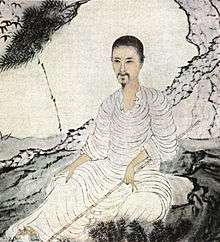
- Bada Shanren (c. 1626–1705), born as Zhu Da (朱耷), was a Chinese painter of shuimohua and a calligrapher. He was of noble lineage, being a descendant of the Ming dynasty prince Zhu Quan. Bada Shanren, a purported child prodigy, began painting and writing poetry in his early childhood. About the year 1644, when the Ming emperor committed suicide and the Manchu army from the north attacked Beijing, the young Han man sought refuge in a Buddhist monastery. His paintings feature sharp brush strokes which are attributed to the sideways manner by which he held his brush. In the 1930s, Chinese painter Zhang Daqian produced several forgeries of Bada Shanren's works. But they are easily spotted by the trained eye, because the modern copies were softer and rounder. Yale University scholar, Wang Fangyu, was a major collector of Bada Shanren paintings from the 1960s until his death in 1997.
- Niu Shihui (Chinese: 牛石慧), Bada Shanren's younger brother. He was also a famous painter.
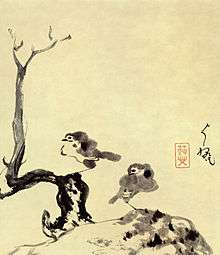 Two Birds
Two Birds Lotus and Birds (荷花小鸟图), Zhu Da, Shanghai Museum
Lotus and Birds (荷花小鸟图), Zhu Da, Shanghai Museum Mynah Bird on an Old Tree, Zhu Da, Palace Museum, Beijing
Mynah Bird on an Old Tree, Zhu Da, Palace Museum, Beijing- Rock and Two Fish
Modern era

- Zhu Jianfan (Traditional Chinese: 朱劍凡; Simplified Chinese: 朱剑凡), (1883–1932), previously named as Zhou Jia Chun (Chinese: 周家純), born in Ningxiang, Hunan province, was a famous revolutionary educator. He founded Zhounan Women's School (Chinese: 周南女學堂) by selling off and contributing all his property, which was valued at 111,700 silver dollars. He held the post of principal until 1927. It is a rare magnificent feat in the educational history of China. In 1911, he led students participate in Anti-Manchurian Revolution, and persuaded Hunan army to correspond to Wuchang Uprising. In 1922, he invited Mao Zedong to live on his campus, and sponsored Mao's library.[70]
- Zhu Rongji[71][72] (born 21 October 1928 in Changsha, Hunan) is a prominent Chinese politician who served as the Mayor and Party chief in Shanghai between 1987 and 1991, before serving as Vice-Premier and then the fifth Premier of the People's Republic of China from March 1998 to March 2003.
- Zhu Qingshi (born 1946), famous chemist, member of Royal Society of Chemistry. He was the former principal of the University of Science and Technology of China. He was also a Delegate of The 8th and 9th National People's Congress, and The 10th National Committee of the Chinese People's Political Consultative Conference.
- Zhu Yunlai (born 1957 in Changsha, Hunan), CEO of the China International Capital Corporation
- Zhu (Chu) Hsuin Urli (born 1908 in Hangzhou, died 1978 in Ohio), graduate of Saint John's University, Shanghai, Beijing University Professor of Medicine. Research Assistant with E.V.Cowdry/Rockefeller Institute in China 1940. PHD Washington University, St Louis Missouri 1947. Emeritus Professor Medicine Case Western Reserve University, Cleveland Ohio.
See also
References
- ↑ Stearns, Peter N., et al. World Civilizations: The Global Experience. AP Edition DBQ Update. New York: Pearson Education, Inc., 2006. 508.
- ↑ Robinson (2000), 527.
- ↑ Atwell (2002), 84.
- ↑ Hucker, Charles O. (January 1985). A Dictionary of Official Titles in Imperial China. Stanford University Press. pp. 262–. ISBN 978-0-8047-1193-7.
- ↑ Richard G. Wang (23 August 2012). The Ming Prince and Daoism: Institutional Patronage of an Elite. OUP USA. pp. 19–. ISBN 978-0-19-976768-7.
- ↑ John W. Dardess (2010). Governing China, 150-1850. Hackett Publishing. pp. 97–. ISBN 1-60384-311-6.
- ↑ http://www.history.ubc.ca/sites/default/files/documents/readings/robinson_culture_courtiers_ch.8.pdf
- ↑ https://www.sav.sk/journals/uploads/040214374_Slobodn%C3%ADk.pdf p 166.
- ↑ "Archived copy" (PDF). Archived from the original (PDF) on 30 June 2016. Retrieved 18 October 2013. p. 230.
- ↑ http://mongol.huji.ac.il/sites/default/files/Robinson_Delimiting%20the%20Realm%20under%20the%20Ming%20Dynasty.pdf p. 22-23
- ↑ http://www.sino-platonic.org/complete/spp110_wuzong_emperor.pdf
- ↑ http://www.cuhk.edu.hk/ics/journal/articles/v60p299.pdf p. 302.
- 1 2 Frederick W. Mote; Denis Twitchett (26 February 1988). The Cambridge History of China: Volume 7, The Ming Dynasty, 1368-1644. Cambridge University Press. pp. 132–. ISBN 978-0-521-24332-2.
- ↑ https://www2.ihp.sinica.edu.tw/file/1428JKwdpCs.pdf p. 52.
- ↑ https://www2.ihp.sinica.edu.tw/file/1428JKwdpCs.pdf
- ↑ John W. Chaffee (1999). Branches of Heaven: A History of the Imperial Clan of Sung China. Harvard Univ Asia Center. pp. 26–. ISBN 978-0-674-08049-2.
- ↑ John W. Chaffee (1999). Branches of Heaven: A History of the Imperial Clan of Sung China. Harvard Univ Asia Center. pp. 261–. ISBN 978-0-674-08049-2.
- ↑ John W. Chaffee (1999). Branches of Heaven: A History of the Imperial Clan of Sung China. Harvard Univ Asia Center. pp. 273–. ISBN 978-0-674-08049-2.
- ↑ John W. Chaffee (1999). Branches of Heaven: A History of the Imperial Clan of Sung China. Harvard Univ Asia Center. pp. viii–. ISBN 978-0-674-08049-2.
- ↑ John W. Chaffee (1999). Branches of Heaven: A History of the Imperial Clan of Sung China. Harvard Univ Asia Center. pp. iv–. ISBN 978-0-674-08049-2.
- ↑ John W. Chaffee (1999). Branches of Heaven: A History of the Imperial Clan of Sung China. Harvard Univ Asia Center. pp. 272–. ISBN 978-0-674-08049-2.
- ↑ http://www.history.ubc.ca/sites/default/files/documents/readings/robinson_culture_courtiers_ch.8.pdf pp. 396-399.
- ↑ https://www.britishmuseum.org/pdf/MING_Protection_From_Seizurel24_07_2014.pdf
- ↑ https://www2.ihp.sinica.edu.tw/file/1428JKwdpCs.pdf p, 74-75, 82
- ↑ (陈博翼), Boyi Chen. "4.3 跋《明秦府承奉正康公墓志铭》"A Sogdian Descendant? Study of the Epitaph of Kang Jing: The Man Who Served at Ming Prince Qin's Mansion," Collected Studies on Ming History 明史研究论丛 9 (2011): 283-297".
- ↑ http://3g.e3ol.com/culture-view.asp?id=25072&page=3&s=3.
- ↑ "明代的大屠杀_acmilan1928_新浪博客". blog.sina.com.cn.
- ↑ "[原创]元惠宗在韩国形象为什么比明神宗强过百倍,因为他流放高丽王拯救高丽百姓 – 铁血网". bbs.tiexue.net.
- ↑ "被明人色情化抹黑的元惠宗及藏密大喜乐法 – 铁血网". bbs.tiexue.net.
- ↑ http://tieba.baidu.com/p/1677002974?see_lz=1
- ↑ Zi, Yolu (17 September 2015). "ziyolu easy hut: 朱元璋祭次子朱樉祝文".
- ↑ .
- ↑ "AG亚游网址,AG亚游网址,AG亚游网址". www.tmallze.com.
- 1 2 Frederick W. Mote; Denis Twitchett (26 February 1988). The Cambridge History of China: Volume 7, The Ming Dynasty, 1368-1644. Cambridge University Press. pp. 425–. ISBN 978-0-521-24332-2.
- ↑ Frederick W. Mote; Denis Twitchett (26 February 1988). The Cambridge History of China: Volume 7, The Ming Dynasty, 1368-1644. Cambridge University Press. pp. 122–. ISBN 978-0-521-24332-2.
- ↑ Frederick W. Mote; Denis Twitchett (26 February 1988). The Cambridge History of China: Volume 7, The Ming Dynasty, 1368-1644. Cambridge University Press. pp. 403–. ISBN 978-0-521-24332-2.
- ↑ Frederick W. Mote; Denis Twitchett (26 February 1988). The Cambridge History of China: Volume 7, The Ming Dynasty, 1368-1644. Cambridge University Press. pp. 404–. ISBN 978-0-521-24332-2.
- ↑ Frederick W. Mote; Denis Twitchett (26 February 1988). The Cambridge History of China: Volume 7, The Ming Dynasty, 1368-1644. Cambridge University Press. pp. 414–. ISBN 978-0-521-24332-2.
- ↑ Frederick W. Mote; Denis Twitchett (26 February 1988). The Cambridge History of China: Volume 7, The Ming Dynasty, 1368-1644. Cambridge University Press. pp. 277–. ISBN 978-0-521-24332-2.
- ↑ Frederick W. Mote; Denis Twitchett (26 February 1988). The Cambridge History of China: Volume 7, The Ming Dynasty, 1368-1644. Cambridge University Press. pp. 514–. ISBN 978-0-521-24332-2.
- ↑ http://geissfoundation.org/wp-content/uploads/2014/02/1MingPrincelyCourts_DMRobinson.pdf
- ↑ Hucker (1958), 31.
- 1 2 3 4 Spence (1999), 16.
- ↑ Ebrey (2006), 281–3.
- ↑ Ebrey (1999), 203–6, 213.
- ↑ Ebrey Cambridge (194), 195.
- ↑ Spence (1999), 21–2.
- 1 2 Spence (1999), 22.
- 1 2 Spence (1999), 25.
- ↑ "Unforgettable Youth-hood (in Chinese)".
- ↑ Zhen Zhou Local Geography, Xin Zhen: "Zhu to Wang"—Zhu's Descendants (in Chinese)
- ↑ "Zhu Yuanzhang's descendants were founded in Qi Xian (in Chinese)".
- ↑ "Yan Zhou Government, Guang Jia Street (in Chinese)".
- ↑ Royal Family Zhu Changed Family Name to 'Dong', went to Guang Dong, and Settled in Zhuang He (in Chinese)
- 1 2 "朱氏宗亲网 www.ZhuWeb.cn 朱氏家族第一门户网站,朱氏子孙交流平台". www.zhuweb.cn.
- ↑ "朱氏宗亲网". www.zhuweb.cn.
- ↑ Stephen Keeling (1 April 2011). The Rough Guide to Taiwan. Rough Guides. pp. 242–. ISBN 978-1-4053-8287-8.
- ↑ Herbert Baxter Adams (1925). Johns Hopkins University Studies in Historical and Political Science: Extra volumes. p. 57.
- ↑ Pao Chao Hsieh (23 October 2013). Government of China 1644- Cb: Govt of China. Routledge. pp. 57–. ISBN 978-1-136-90274-1.
- ↑ Pao C. Hsieh (May 1967). The Government of China, 1644-1911. Psychology Press. pp. 57–. ISBN 978-0-7146-1026-9.
- ↑ Jonathan Manthorpe (15 December 2008). Forbidden Nation: A History of Taiwan. St. Martin's Press. pp. 108–. ISBN 978-0-230-61424-6.
- ↑ Eiko Woodhouse (2 August 2004). The Chinese Hsinhai Revolution: G. E. Morrison and Anglo-Japanese Relations, 1897-1920. Routledge. pp. 113–. ISBN 978-1-134-35242-5.
- ↑ Jonathan D. Spence (28 October 1982). The Gate of Heavenly Peace: The Chinese and Their Revolution. Penguin Publishing Group. pp. 84–. ISBN 978-1-101-17372-5.
- ↑ Shêng Hu; Danian Liu (1983). The 1911 Revolution: A Retrospective After 70 Years. New World Press. p. 55.
- ↑ The National Review, China. 1913. p. 200.
- ↑ Monumenta Serica. H. Vetch. 1967. p. 67.
- ↑ Percy Horace Braund Kent (1912). The Passing of the Manchus. E. Arnold. pp. 382–.
- ↑ M.A. Aldrich (1 March 2008). The Search for a Vanishing Beijing: A Guide to China's Capital Through the Ages. Hong Kong University Press. pp. 176–. ISBN 978-962-209-777-3.
- ↑ Hay 2001, pp. 1, 84
- ↑ "【周南中学】朱剑凡". www.zhounan.com.
- ↑ Andreas, Joel (2009). Rise of the red engineers: the Cultural Revolution and the origins of China's new class. Stanford: Stanford University Press. p. 244. ISBN 9780804760775.
- ↑ McCarthy, Terry (12 April 1999). "Zhu Rongji's Year of Living Dangerously". Time.
